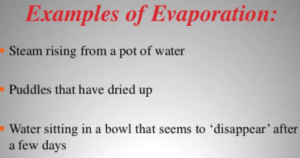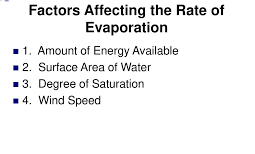Best Examples of Evaporation in daily life
Evaporation is the process of changing liquid into vapors. Common Examples of Evaporation are provided here in detail. This post also includes Factors affecting evaporation.
Keep reading …
This post includes:
- Evaporation Definition
- Evaporation examples
- Factors affecting evaporation
- Uses of evaporation
- Much more
What is Evaporation?
Evaporation is a physical process of slow gradual transition of a liquid into a state gaseous, having acquired sufficient energy to overcome the surface tension. Unlike boiling, evaporation can occur at any temperature, the faster the higher this is. The entire mass does not need to reach the boiling point.
Examples of Evaporation

Here is the list of Examples of Evaporation that are used in daily life:
- Wet clothing placed outdoors dries due to the evaporation of water.
- The puddles that form after the rain, which evaporate once the sun rises.
- Cloud formation, which originates in part from the evaporation of seawater.
- Liquid drops on the inside of the lid of a saucepan when it is cooking, which is caused by the evaporation of the water in the container.
- The melting of an ice cube at room temperature, since once the water is in a liquid state it will begin to evaporate.
- Evaporation from a glass of alcohol or ether is placed at room temperature.
- When steaming, the water evaporates and the steam generated cooks the food.
- The smoke coming out of a hot cup of tea or coffee is only part of the liquid evaporating.
- Evaporation of dry ice in contact with air.
- Water vapor is released at high pressure from inside a boiler.
- The sweat on the skin when we exercise disappears due to progressive evaporation.
- The evaporation of salty seawater, which leaves behind sea salt.
How Evaporation Occurs?
Evaporation is a physical process by which the material passes from the liquid state to the gaseous state.
The evaporation occurs once the liquid receives a certain amount of thermal energy and provided there is a free space above the liquid, in which case the surface tension of the liquid and some molecules pass the gaseous state is broken. The amount of gaseous matter that is generated determines the saturating vapor pressure, which depends on the evaporating substance and on the temperature.
How Boiling Is Different from evaporation?
Evaporation should not be confused with boiling. While both are considered examples of physical change, they differ in that:
- Evaporation is a slow and gradual process that can occur at any temperature (faster the higher is the temperature), while …
- The boiling only is produced at a specific temperature level for each substance, the so-called boiling. Boiling occurs when the vapor pressure of the liquid is equal to atmospheric pressure, while evaporation occurs when the amount of the gas is less than the saturating vapor pressure.
Factors affecting evaporation
-
Temperature
 At higher temperatures, more molecules of a liquid are moving with high velocities. Thus, more molecules escape from their surface. Thus, evaporation is faster at high temperatures than at low temperatures.
At higher temperatures, more molecules of a liquid are moving with high velocities. Thus, more molecules escape from their surface. Thus, evaporation is faster at high temperatures than at low temperatures.
-
Surface area
Larger is the area of a liquid, a greater number of molecules have the chance to escape from its surface. Therefore there will be more evaporation at sea than the river and small reservoirs of water.
-
Wind
Wind blowing over the surface of liquid sweeps away the liquid molecules that have just escaped out. This increases the chance for more liquid molecules to escape out.
-
Humidity of surrounding air
When we say that air is humid it means there is a lot of water vapors present in the air. The rate of evaporation decreases with the increase in humidity. For example, wet clothes do not dry easily if the surrounding air is wet and damp in-home take a long time to dry on a rainy day. From this example, we concluded that the rate of evaporation increases with decreasing humidity.
In another example, if we sleep in an air-conditioned room where the humidity of air is very low, due to this our skin and throat feel very dry.
-
Pressure
Evaporation increases by the decrease in atmospheric pressure. For example, wet objects dry rapidly on the mountain top where atmospheric pressure is less than sea level.
People May search Also:
